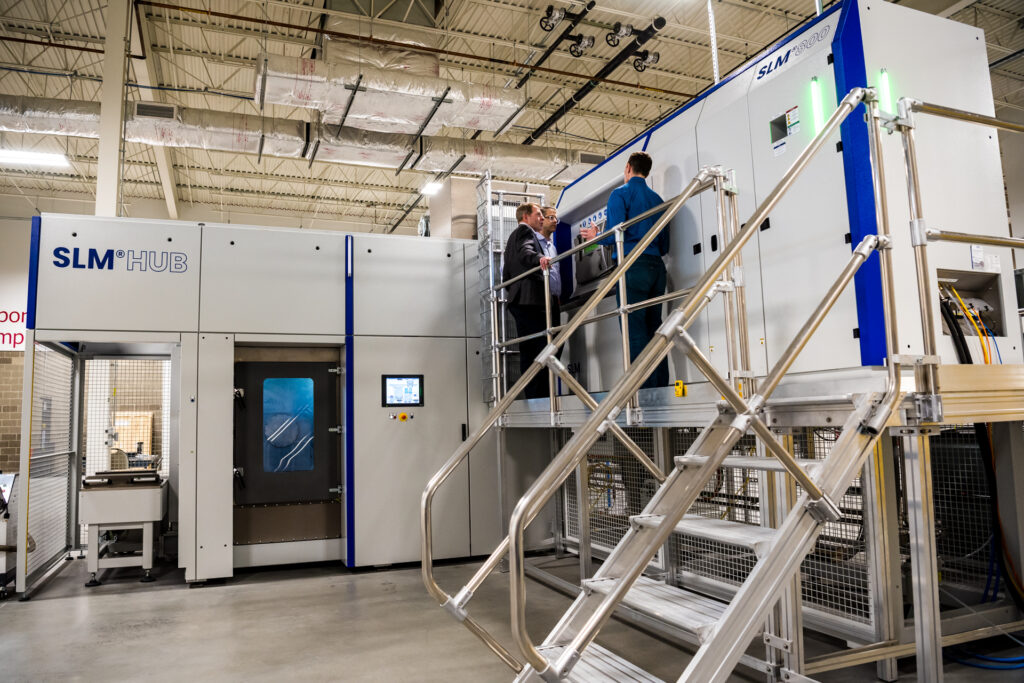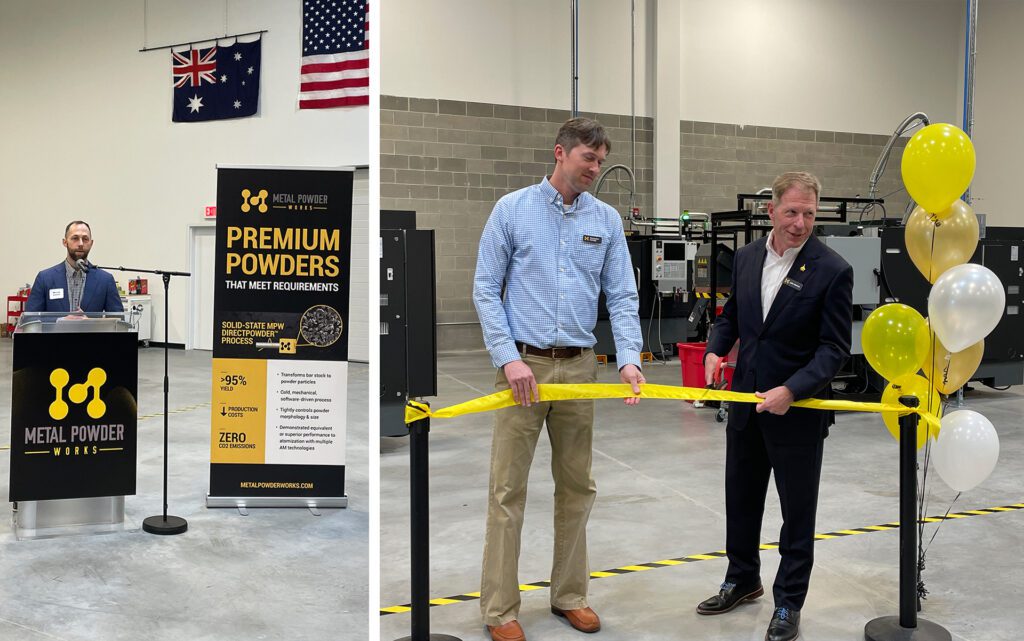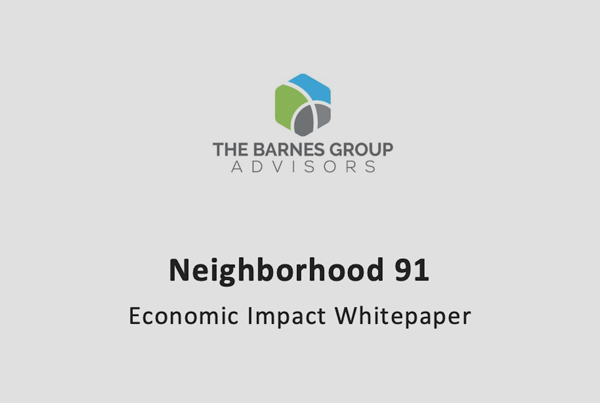The Neighborhood 91 additive manufacturing (AM) campus at Pittsburgh International Airport was built to connect all elements of the AM manufacturing process, connecting manufacturers with cutting-edge technology to advance their businesses.
That mission aligns closely with that of America Makes, a public-private partnership focused on additive manufacturing technology and education based in nearby Youngstown, Ohio.
On Monday, the executive director of America Makes, John Wilczynski, visited the campus to tour the flagship facility opened by Fortune 500 manufacturer Wabtec last summer. The 11,000-square-foot space features an SLM 800 3D printer, one of only four in the country at the time it was installed.
Along with John Barnes, founder and managing director of The Barnes Global Advisors and a member of America Makes’ executive committee, Wilczynski spoke with Wabtec engineers and watched the printer in action.
They also took a few minutes to speak with Blue Sky News about the future of the AM industry and what role Neighborhood 91 will play in it. The following interview is edited for length and clarity.
BSN: Tell us about America Makes and its mission.
JW: America Makes is a public-private partnership focused on increasing the adoption of AM. So ultimately, we’re trying to get people to increase their awareness, be educated on, and understand where additive potentially fits into their business models. There are right around 250 member groups, and that ranges from federal agencies to national labs to universities to nonprofits, large OEMs (original equipment manufacturers) and very small organizations. About 55 to 60 percent of our membership is small businesses.
BSN: What progress do you see advanced manufacturing making in the next five years, both in terms of the science and the industry?
JB: AM is a complex beast because it’s the integration of things like robotics, automation, AI. I think that it’s difficult for small and medium enterprises to pick up on AM. It requires a lot of integration, and it requires a lot of understanding on multiple fronts. So that’s a little bit of the idea behind the Neighborhood 91 campus. In Pittsburgh, you have a lot of ingredients around automation. I mean, you can’t read a research paper that doesn’t reference Carnegie Mellon University or the University of Pittsburgh or Penn State; this area’s full of good universities and colleges. All of those are good ingredients, and it’s a little bit unique to Pittsburgh, I think.

BSN: On the flip side, what are the challenges in the next few years for AM?
JW: There’s a couple of different approaches that people are taking right now, when trying to demonstrate how to use additive manufacturing to realize some output. At the end of the day, that’s why the folks at Neighborhood 91 are here. They see it aligning to their road maps moving forward. I think what’s interesting about this campus and how it’s setting up is [that] it’s not, “Throw everything into one building and bring people in to see our monument of how it could work.” These are all individual organizations that are teaming up together. A lot of these pieces are in the region already; it depends on how big you want to make that circle, but within even 100 miles from here, all of the pieces exist. One of the challenges is, even though they’re that close, they’re still far apart. It’s amazing how many people don’t realize what their neighbor does and how they can potentially team up to do something meaningful. I think for us, awareness [of AM] is one of our biggest challenges.
BSN: What does that advocacy look like? How do you have conversations with people who are unfamiliar or maybe even skeptical about AM?
JB: We usually start with what it is and what it isn’t and describe additive as a manufacturing tool. It goes back to the typical engineer’s question: what problem am I solving? Am I solving a supply chain problem? A cost problem? A performance problem? Additive can do all of these things, but depending on where you’re at, you need to attack it from that aspect. This campus was set up to solve the supply chain issue, which was a particular issue with metal additive. To John’s point, you start looking two to four hours around Pittsburgh, and all of that supply chain exists that was needed, but they don’t talk to each other. I think what’s encouraging is precision manufacturers are now coming into additive—they’re already making parts—and they just want to know how additive can help them do what they do better.
JW: We both came from manufacturing careers, where some of the folks in the additive community have not. They grew up with technology or developed the technology but hadn’t manufactured a lot. And I think what’s really exciting right now is we’re historically a community that has manufactured and built, ultimately, the country the last hundred and some years. As you bring that knowledge to this technology, we’re starting to see where we can really make some big wins. You start to incorporate the cliché of “the new tool in the toolbox.” It’s a really complicated tool that has a lot of capability, but you have to know how to use it.
BSN: What’s the potential for Neighborhood 91? Is this a possible blueprint for the whole industry, particularly as the pandemic exposed some weaknesses in the global supply chain?
JW: We were pulled into a lot of different initiatives around responses to these issues. And the one major outcome of that was AM is able to be distributed, but what do we mean by that? Is it in your garage and all you have to do is hit a button? Or does it mean you go to certain areas of expertise where you need them and what you need them for? I see this campus as that center of excellence for the technology that can be looked to, but it needs to be reproduced. The one major thing we should take away from the last couple of years is just because we’re really good at producing this particular kind of product in one specific place, it doesn’t work when that chain gets cut off. So distribution is important. And as part of that, we’re trying to understand how the small and medium manufacturers connect back to the larger needs of the community.
JB: You’ve got great universities (in Pittsburgh) like Pitt and CMU and they invent things, and now we’ve got Mill 19 and Hazelwood Green, which is like the development flavor. The final mile is the production piece of it, so you’ve got Neighborhood 91 there. And when you take a step back and ask, “What’s Pittsburgh doing about AM?”, between Hazelwood Green and Neighborhood 91, that’s 400 acres of development and production capability. And I would be surprised if that’s matched anywhere in North America.
Source: Blue Sky News


